“A big chunk of nature in the city, wild and strange”—James Corner’s description of Freshkills Park hits the mark on several fronts. Big chunk of nature? At almost four square miles (2,300 acres) in western Staten Island, Freshkills is roughly three times the size of Central Park and almost certainly the last large designed park that will be built in New York City. Wild? The vast tract is covered in profuse growth, mostly self-propagating, having been produced by seeds carried onto the site by wind or birds. And strange? Not as strange as it was when the site served for over half a century as the world’s largest landfill, but it remains an unusual scene, with its four steep mounds of collected waste that are capped and undergoing remediation.
It is hard to believe, when viewing Freshkills Park (the name derives from the Dutch Kille, or channel), and its vast grasslands, stands of trees, woodland edges, wetlands, and tidal creeks, that it is a mere 12 miles from the southern tip of Manhattan. One observer, the landscape architect Matt Urbanski, has described Freshkills as closer to a Midwestern prairie than to an east-coast green space. Certainly it is a park like no other. While Mark Murphy, administrator of Freshkills Park and president of the Freshkills Park Alliance, notes that it has been designated a large designed park—the first in over half a century in the city and the last one that will be built there—Corner considers his work at Freshkills as being “more like a farmer cultivating land than traditional landscape architecture.”
Unlike a farm, however, the site handed to Corner’s New York–based Field Operations, with the four mounds named according to the four cardinal directions, was heavily contaminated. These piles of collected waste had to be remediated before work could begin. Since the mid-20th century, innumerable industrial sites around the world have been converted to parkland. In every case, the site’s previous use, be it factory, quarry, or railroad, left brownfields in need of decontamination. But the condition left by the Staten Island landfill marked a particularly aggressive assault on nature. The NYC Department of Sanitation, which controls Freshkills in collaboration with the city’s Department of Parks & Recreation, has undertaken the Herculean job of capping the mounds, which requires collecting and treating methane, the combustible gas produced by the decomposition of organic matter. The steel-cased gas wellheads that occasionally poke up from the grass-covered slopes attest to the process. (The city sells the purified natural gas to the local utility.) Hazardous materials have been removed, and between 6 to 16 feet of topsoil have been added to North Park; 100,000 cubic yards of clean soil comprised 70 percent of the cost.
The main feature is an outsize bioswale, which extends from the parking entrance through the whole length of the park. This stepped landscape element, part of the stormwater infrastructure that feeds into the wetlands, matches the huge scale of the mounds and the scattered industrial remnants that have been left in place. The same scale and industrial aesthetic inform the robust galvanized-steel tables and benches designed by Field Operations; the signage, by Wkshps, is neat and informative. Attention to ongoing sustainability is evident in the comfort stations’ composting toilets (prefabricated by Clivus Multrum) and the solar panels that provide power for lighting in the parking lot (the only area with illumination).
The park offers numerous activities. A wide asphalt biking strip and an equally wide gravel pedestrian path run along either side of the bioswale. The bike and pedestrian trails will eventually connect with those in the 3.2 mile Springville Greenway (2015) and the Staten Island Greenbelt. A pristine bike-repair station in the parking lot provides a gamut of up-to-date tools for bicycle maintenance. Judging from the number of cyclists of all ages swarming through the park, this will undoubtedly be one of its most popular attractions. At the far end of the paths is a galvanized-steel lookout tower that signals North Park’s other favorite attraction: watching the numerous bird species—bald eagles, 19 families of osprey, red-tailed hawks, American kestrel, and northern harrier—that have moved, together with deer and foxes, into the renewed landscape.
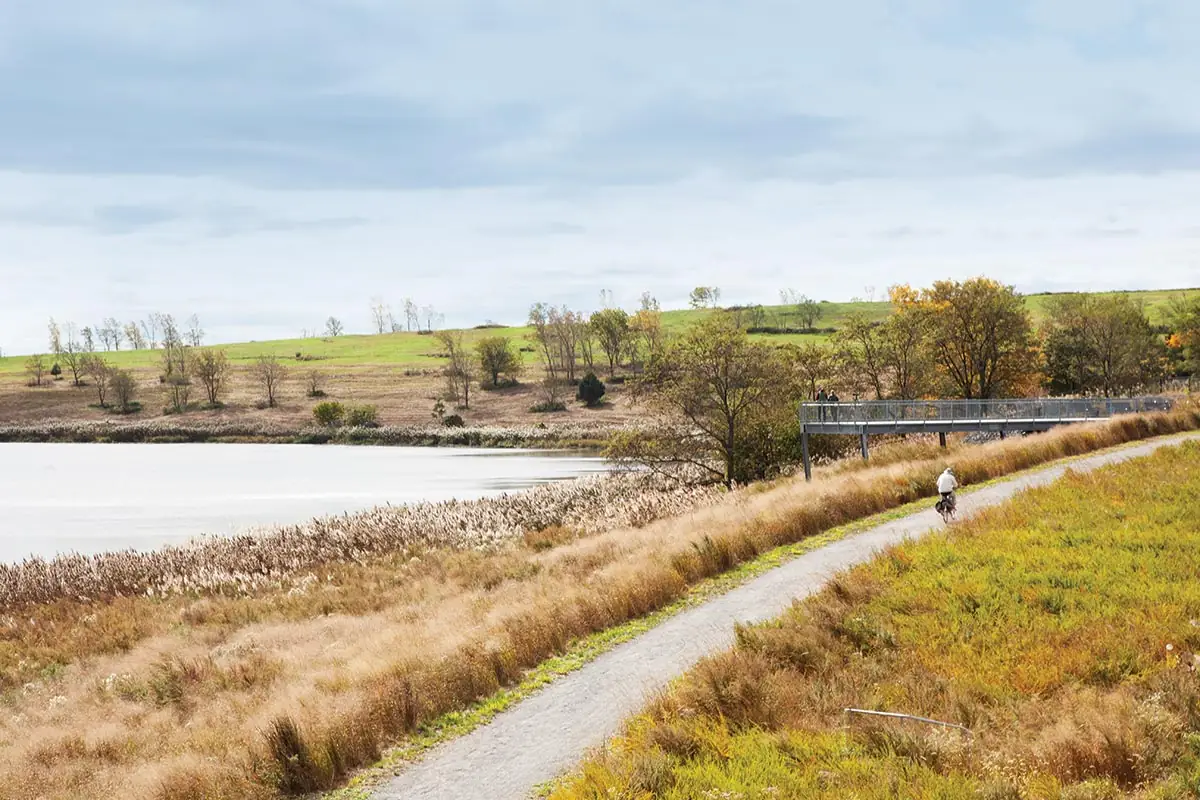
Bike trails are among the park’s most popular features. Photo © Mona Miri, click to enlarge.
A planned seed nursery of native plants will serve the park and sell to the public. The nursery will also support an existing curriculum that teaches the ecological importance of grasslands to approximately 3,000 schoolchildren, primarily from Title 1 schools that serve students from low-income families. So far, this is the only program scheduled for Freshkills, which, unlike other urban parks with their multiple activities, is simply about enjoying nature in this unnatural site.
North Park’s relationship to the community is most evident at the entrance from Schmul Playground at its northwest. Renovated by Field Operations in 2012, this 8.5-acre open space contains a playground, picnic lawn, and sports facilities. Peripheral projects of this kind—another is Owl Hollow Soccer Fields, part of the future South Park—were meant to attract attention to the mammoth Freshkills. A long, elegant pedestrian avenue planted with oak and sweet gum trees connects Schmul Park and North Park. The nearby entrance hill, bordered by swaths of dense switchgrass, raises the visitor into the quiet vastness of the whole. The view encompasses William T. Davis Wildlife Preserve, a tidal wetland, and the cleanest estuary in the tristate region, which is understandably popular with kayakers.
North Park’s mini-taste of Freshkills is something of a tease—South Park, slated to be next to open, has not yet started construction, according to Corner—and while Freshkills as a whole is scheduled for completion by 2036, there is no definite timeline. Corner points out that a great deal more time-consuming preparation is needed to assure healthy, safe conditions, and accessibility. Stay tuned!
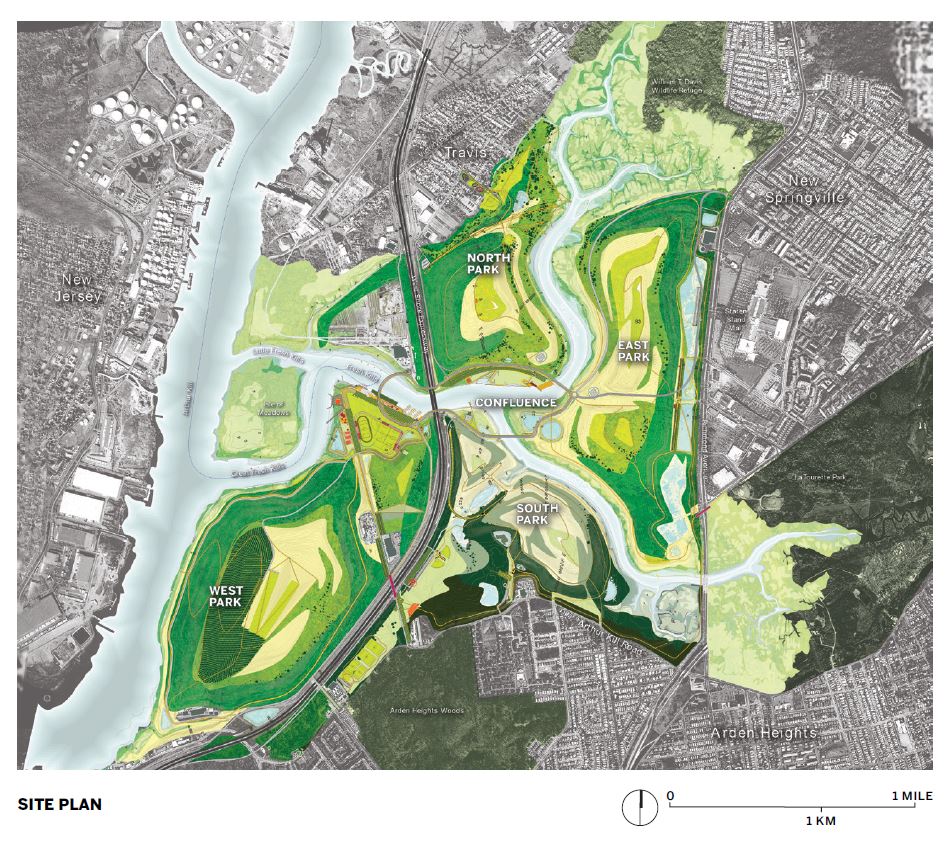


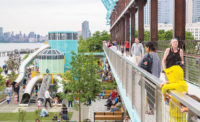
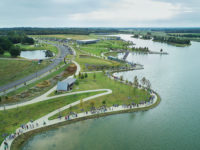
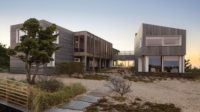
Post a comment to this article
Report Abusive Comment